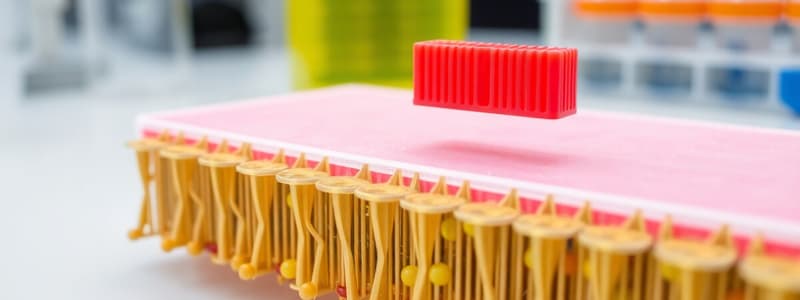Podcast
Questions and Answers
What is the maximum number of justified absences allowed during the course?
What is the maximum number of justified absences allowed during the course?
- Two (correct)
- Three
- Four
- One
Which of the following is NOT a required item for laboratory safety?
Which of the following is NOT a required item for laboratory safety?
- Gloves
- Goggles
- Lab coat with cuffed sleeves
- Safety helmet (correct)
What should a student do in case symptoms such as fever or coughing occur?
What should a student do in case symptoms such as fever or coughing occur?
- Continue attending the lab.
- Leave the lab without notifying anyone.
- Inform the lecturer immediately. (correct)
- Attempt to complete the lab experiment.
How should students move and communicate in the lab to ensure safety?
How should students move and communicate in the lab to ensure safety?
What is the purpose of keeping a laboratory notebook?
What is the purpose of keeping a laboratory notebook?
What should students do before attending a lab session?
What should students do before attending a lab session?
What is the proper way for students to handle personal emails to faculty?
What is the proper way for students to handle personal emails to faculty?
How should lab surfaces be treated before and after experimentation?
How should lab surfaces be treated before and after experimentation?
What is the expected behavior of red blood cells in a hypertonic solution?
What is the expected behavior of red blood cells in a hypertonic solution?
Which component of red blood cells is primarily responsible for oxygen transport?
Which component of red blood cells is primarily responsible for oxygen transport?
During the microscopy procedure for onion plant cells, what is the purpose of adding coverslips?
During the microscopy procedure for onion plant cells, what is the purpose of adding coverslips?
What is the unique characteristic of mature red blood cells?
What is the unique characteristic of mature red blood cells?
What is the primary reason for including different solutions (A, B, C) during the blood slide experiment?
What is the primary reason for including different solutions (A, B, C) during the blood slide experiment?
Which of the following is NOT a part of the onion plant cell structure that should be labeled during observation?
Which of the following is NOT a part of the onion plant cell structure that should be labeled during observation?
What initial action should be taken before observing the blood drop under a microscope?
What initial action should be taken before observing the blood drop under a microscope?
What is the normal concentration range of red blood cells in blood?
What is the normal concentration range of red blood cells in blood?
What would occur to a plant cell placed in a hypotonic solution?
What would occur to a plant cell placed in a hypotonic solution?
Which statement best describes diffusion?
Which statement best describes diffusion?
What is the key role of selectively permeable membranes in cells?
What is the key role of selectively permeable membranes in cells?
Which condition is most likely to cause a human cell to undergo crenation?
Which condition is most likely to cause a human cell to undergo crenation?
What determines the direction of osmotic movement in plant cells?
What determines the direction of osmotic movement in plant cells?
How should a scalpel be held during a laboratory experiment?
How should a scalpel be held during a laboratory experiment?
What is the primary reason for using safety glasses during an experiment?
What is the primary reason for using safety glasses during an experiment?
Which process is primarily responsible for maintaining homeostasis in living organisms?
Which process is primarily responsible for maintaining homeostasis in living organisms?
Flashcards
Lab coat
Lab coat
A protective garment worn in laboratories to protect the wearer's clothes from spills and chemicals.
Goggles
Goggles
A personal protective equipment used to prevent contamination of eyes and face from splashes or projectiles.
Gloves
Gloves
A protective barrier worn on hands to prevent contamination and protect the wearer from hazards.
Laboratory Notebook
Laboratory Notebook
Signup and view all the flashcards
Know your surroundings
Know your surroundings
Signup and view all the flashcards
Work in silence
Work in silence
Signup and view all the flashcards
C1.V1=C2.V2
C1.V1=C2.V2
Signup and view all the flashcards
Report symptoms to the instructor
Report symptoms to the instructor
Signup and view all the flashcards
Diffusion
Diffusion
Signup and view all the flashcards
Osmosis
Osmosis
Signup and view all the flashcards
Hypertonic Solution
Hypertonic Solution
Signup and view all the flashcards
Hypotonic Solution
Hypotonic Solution
Signup and view all the flashcards
Isotonic Solution
Isotonic Solution
Signup and view all the flashcards
Turgid Plant Cell
Turgid Plant Cell
Signup and view all the flashcards
Flaccid Plant Cell
Flaccid Plant Cell
Signup and view all the flashcards
Selectively Permeable Membrane
Selectively Permeable Membrane
Signup and view all the flashcards
Lysis
Lysis
Signup and view all the flashcards
Crenation
Crenation
Signup and view all the flashcards
Hemoglobin
Hemoglobin
Signup and view all the flashcards
Anucleate (Red Blood Cells)
Anucleate (Red Blood Cells)
Signup and view all the flashcards
Study Notes
Lab Exercise 1: Membrane Permeability
- Course: Molecular and Cellular Biology (MD105)
- Semester: Fall 2024
- Instructors: T.C. Kyriakou & D. Markantoni
- Topic: Membrane permeability of onion plant cells and human red blood cells
COVID-19 Safety Protocol
- Lab Entrance: Be on time to avoid crowds.
- Protective Gear: Always bring lab coat with cuffed sleeves, mask, and goggles.
- Lab Entry: Students without the required protective gear will not be allowed in the lab.
- Hand Hygiene: Wash hands with soap and put on gloves.
- Surface Disinfection: Disinfect working surfaces before and after each experiment.
- Health Concerns: Report fever, cough, or breathing difficulties immediately.
Absences
- Mandatory Participation: Physical presence is required unless permission is granted. -Two excused absences are allowed for serious health conditions or emergencies
- Pre-notification for permitted absences required.
- Repeat Experiments: Lab experiments cannot be repeated.
Preparation and Equipment
- Material Study: Study the provided materials before the lab.
- Protocol Printing: Print out the experiment protocol or methodology.
- Material Marking: Mark necessary tools and materials on the protocol.
- Preparation: Be mentally prepared for complex tasks.
- Attire: Required: Closed-toe shoes, lab coat, goggles, and gloves.
- Hair: Tie back hair.
- Food and Drink: No food or drinks allowed in the lab.
Lab Notebook
- Record Keeping: Take notes during all lab instructions and explanations.
- Protocol Application: Record each protocol application with dates.
- Reagent Calculations: Do reagent concentration calculations (e.g., C1V1 = C2V2).
- Result Evaluation: Evaluate results and note areas requiring improvement.
Lab Conduct
- Movement: Move as if in a bubble to avoid collisions.
- Awareness: Be aware of your surroundings.
- Teamwork: Work as a team, respecting others.
- Communication: Raise your hand to ask questions.
- Quiet Work: Maintain a quiet work environment.
Contact Information
- Email (Instructor 1): [email protected] (N41)
- Email (Instructor 2): [email protected] (N42)
- Office: N30 (2nd floor, New Building) -Email communications should be sent through university accounts.
Objectives
- Plant and Human Cell Diffusion: Observe how different solutions affect the diffusion of plant and human cells.
- Cellular Environments: Differentiate between hypertonic, hypotonic, and isotonic solutions in cellular environments.
- Cell Transport: Compare and analyze cell transport activity in both plant and human cells.
Safety Precautions
- Food and Drink: Do not eat or drink in the lab.
- Personal Protective Equipment (PPE): Wear safety glasses, lab coat, and gloves during all experiments.
- Scalpel Use: Use scalpels carefully. Handle them as you would a pencil and cut in a downward motion,avoiding pushing too hard. Be extra careful regarding the placement of your specimen holding hand.
- Task Specificity: Use the tools for their intended purpose only.
- Glassware Handling: Be cautious when using glass slides and cover slips.
Diffusion
- Cellular Function: Living organisms rely on the movement of nutrients, water, and waste to maintain homeostasis within their cells.
- Cellular Regulation: Movement of cellular materials is regulated by membranes surrounding organelles and the plasma membrane.
- Selectively Permeable Membranes: Cell membranes are selectively permeable.
- Aqueous Environment: Cells exist in an aqueous environment with dissolved solutes (salts and organic molecules).
- Diffusion Mechanism: The simplest method for molecular movement is diffusion: moving from higher to lower concentrations until equilibrium.
- Energy Requirement: Diffusion does not require energy expenditure.
Osmosis
- Comparison to Diffusion: Osmosis is a specific type of diffusion involving water molecules across a semipermeable membrane.
- Concept and Movement: The net movement of water molecules from a high water concentration to a low water concentration through a membrane
Onion Plant Cells
- Hypotonic: If a plant cell is surrounded by a solution with a higher water concentration than the cell's interior, water enters the cell, causing it to become firm (turgid).
- Isotonic: A solution with an equal concentration of water inside and outside the cell. No significant water movement occurs
- Hypertonic: If a plant cell is surrounded by a solution with a lower water concentration than the cell's interior, water leaves the cell, causing it to become limp (flaccid).
Experimental Procedure (Part A: Onion Cells)
- Onion Preparation: Peel the onion and place the layer on a slide shiny side up.
- Labeling: Label the slide with group and solution details.
- Solution Application: Add a small drop of Solution A to the tissue.
- Coverslip Placement: Carefully place a coverslip, avoiding air bubbles.
- Repeat: Repeat multiple times with other solutions
Experimental Procedure (Part B: Red Blood Cells)
- Blood Sample: Add a drop of blood to a clean slide
- Labeling: Label the slide with identifiers of the sample.
- Solution Application: Add small drops of Solutions A, B, and C to the blood samples
- Coverslip Placement: Cover each sample with a slide and avoid creation of air bubbles
- Microscope Observation: View each of the samples with a microscope, under different magnification
- Record and Comparison: Label the components present and decide which solution applies to each slide.
Questions
- The provided text includes a list of questions related to theoretical concepts and observed outcomes in the lab exercise, for students to answer in the following pages/slides.
Studying That Suits You
Use AI to generate personalized quizzes and flashcards to suit your learning preferences.





